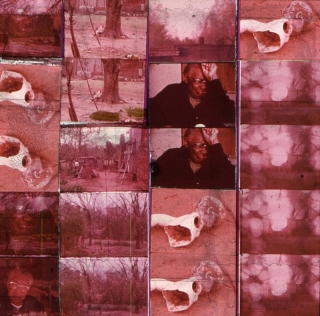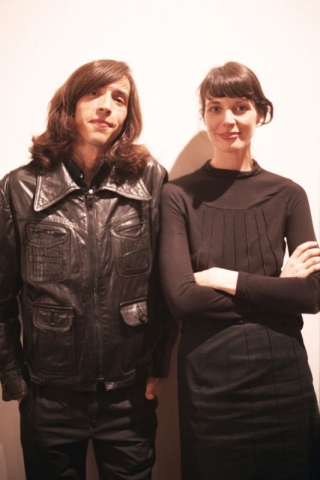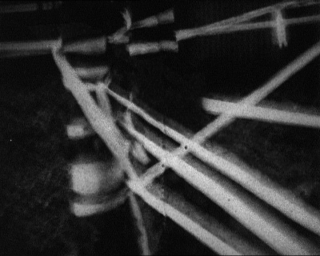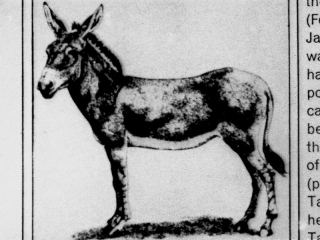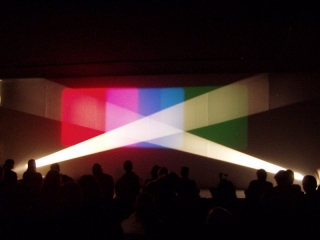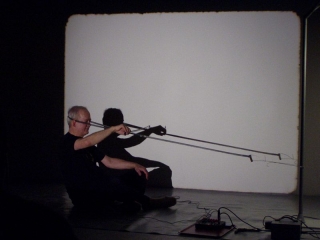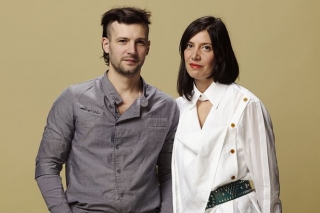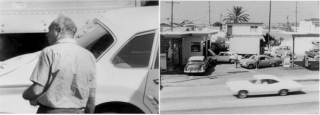Date: 29 October 2006 | Season: London Film Festival 2006 | Tags: London Film Festival
SHINE ON
Sunday 29 October 2006, at 9pm
London National Film Theatre NFT3
Luther Price, Same Day Nice Biscotts, USA, 2005, 6 min
A bleak but touching incantation composed from 13 identical prints of an early 70s documentary on elderly Afro-Americans. Time has taken its toll on the raw material too: now faded and worn, it is steeped in pathos.
Ken Jacobs, Krypton is Doomed, USA, 2005, 34 min
The original Superman radio play from 1940 accompanies the mind-bending ‘Nervous Magic Lantern,’ a filmless projection system that twists light into a perpetually throbbing mass of impossible depth. Presented by the film-maker as a metaphor for the onset of WWII, the apocalyptic narrative could be read as allegory for the present, a world of instability with the potential of environmental collapse.
Courtney Hoskins, The Counter Girl Trilogy, USA, 2006, 6 min
In an inventive response to the cosmetics industry, Hoskins has created imagery from some unusual materials discovered while working as a sales assistant on a make-up counter.
Dietmar Brehm, Blah Blah Blah, Austria, 2006, 13 min
Hotwiring history, the film-maker excavates his image bank of 16mm footage to reveal an archaeology of clandestine pursuits that hovers between ennui and agitation. Brehm’s week beats your year.
Barbara Sternberg, Surfacing, Canada, 2005, 10 min
An exodus of ghostly footsteps pass through the frame beneath layers of scratched emulsion, suggesting the transience of being and a state of emergence beyond the everyday.
Michael Robinson, And We All Shine On, USA, 2006, 7 min
‘An ill wind is transmitting through the lonely night, its signals spreading myth and deception along its murky path. Conjuring a vision of a post-apocalyptic paradise, this unworldly broadcast reveals its hidden demons via layered landscapes and karaoke, singing the dangers of mediated spirituality.’
PROGRAMME NOTES
SHINE ON
Sunday 29 October 2006, at 9pm
London National Film Theatre NFT3
SAME DAY NICE BISCOTTS
Luther Price, USA, 2005, 16mm, colour, sound, 6 min
A mournful dissolving jewel set in bruised magenta sends out votive glints of dying light. A lone bird chirps and branches cover our eyes. Working from a stack of abandoned multiple film prints (nearly identical and close to thirteen in number), Luther Price makes reiterative loops that underline futility, echo hope, and mark every camera movement with the vain promise of fresh outcome and inevitable predestination. (Mark McElhatten)
KRYPTON IS DOOMED
Ken Jacobs, USA, 2005, video, colour, sound, 34 min
In his 5th floor walk-up on the Lower East Side, Jack Smith was determined to complete the beautification of his kitchen cabinet. AIDS was pressing. His friends pitched in, accepting slave status. Jack demanded this and Jack demanded that but because he wanted it perfect (as he had wanted his films to be perfect), and because perfection proved elusive, the remodeling finally had to be abandoned. Each friend going his or her own sad way. We are living under the imminent threat of GODS. The Republican ploy of allying with the religious right for votes is proving shortsighted (grasping individuals tend to be shortsighted) and, as in Iraq, our own religious crazies are now avid for fulfillment. Of prophecy. You’ve got to hand it to those who resist, for the sake of the grass and the animals and the children, and for the preservation of the occasional work of art among the Fabergé eggs, and who knows but that they will succeed against all odds and swerve their respective societies away from sure doom. We like to think so, and it’s easy to, after a lot of movies and the fact that all the living are beneficiaries of the ones who made it through – through normal attrition, that is, all those Papas and especially Mamas that did succeed in sending forward their young. In the late 1930s two Jewish teenagers came up with the story of a couple that sent their infant child on a lone trip of escape through space from an exploding planet. We all know the story: the boy would survive on Earth but would have to keep his identity secret. Were Joe Shuster and Jerry Siegel dreaming out loud? Was Krypton the Old World heading into WWII and was the child escaping the fate of the Jews of Europe? The Jews then, all of us now. Jack’s friends failed to convince him to make a will. ”Why bother?” he asked. ”To protect your work in the future.” ”The future?” Jack replied, “The future will be worse.” (Ken Jacobs)
THE COUNTER GIRL TRILOGY
Courtney Hoskins, USA, 2006, 16mm, colour, silent, 6 min
To make ends meet, I took a job as a makeup counter salesperson. At first, I found this employment to be very satisfying. I was able to smell perfumes all day and ‘paint’ faces with makeup. After all, the human face is a fascinating canvass. The most subtle change can have dramatic effects (for example, it is amazing what a small touch of purple on the eyelids can do for green eyes) ! One day, that bottle of perfume came crashing down on the tile floor. The stench of reality woke me from my drugged state. I was required to go through several training seminars given by the cosmetics corporate giant. Nestled comfortably in the Rocky Mountains, I sat in horror as the ‘rep’ went over our ‘job duties’. My job went from ‘makeup artist’ to ‘scam artist’ right before my eyes! I learned that the average woman in Western society uses twenty cosmetics products each morning. I learned that this ‘average woman’ will also spend money she doesn’t have on cosmetics before spending it on anything else. Most disturbingly, I learned how to manipulate women by playing off of their insecurities. It’s no wonder these companies are so powerful. I couldn’t immediately quit my job, so I tried to make the best of it. One day, I happened upon three amazing shades of lip gloss that were hidden away in a drawer. Although they were for sale, they were not on the display wall. These particular lip glosses contain cholesterol, which in 1888, Fredrich Reinitzer discovered could be manipulated to exist as a new state of matter. He soon coined the word ‘liquid crystal’. I had been trying to purchase liquid crystal materials for my films for some time. I had only managed to find one or two different types. Because the materials are used in computer screens (and, as I learned, lip gloss), they are kept under wraps. I would never have guessed that such incredible materials would have fallen into my lap while working one of the worst jobs I have ever had. (Courtney Hoskins)
BLAH BLAH BLAH
Dietmar Brehm, Austria, 2006, 16mm, colour, sound, 13 min
An essay on restlessness: Blah Blah Blah (based on a song by Iggy Pop: Dietmar Brehm “never really liked it”, but likes it for that very reason) contains a large number of various kinds of shots in a montage which alternates between contemplative scenes and rapid cascades of images. Brehm uses sounds of rain and thunder, with which he is quite familiar, on the soundtrack. In addition a beat measures the rhythm, and its regularity is what makes the Blah Blah Blah project ‘measurable’. Dietmar Brehm has devoted himself to filming his own footage at a higher speed. He uses images typical of a still life (whisky bottles, ashtrays, etc.) and refracts them ironically (a chair stands on two legs), combines them with footage used in earlier works, and arranges them in a row like fragmentary thoughts. The result is a consciousness film par excellence. In Blah Blah Blah Brehm examines his own film oeuvre, not for the purpose of seeing what he has achieved, but in the interests of casually increasing its intensity. Instead of intruding into the images, he merely touches upon them lightly this time. All hope for calm, such as with a shot of a statue in a park, is disappointed because, in Blah Blah Blah, Brehm has applied the principle of the mental foray to his own film, which he shoots with his camera, speeds up, turns around, and makes absorb itself: Blah Blah Blah becomes ‘Blah Blah Blah’. Only those viewers who share the restlessness will recognize the inversion. (Bert Rebhandl)
SURFACING
Barbara Sternberg, Canada, 2005, 16mm, colour, sound, 10 min
“The world is too much with us; late and soon,
Getting and spending, we lay waste our powers…”
(William Wordsworth)
Our busy comings and goings, on the move, working at life, are pictured through layers of images and scratched emulsion. Movement through various planes struggles towards emergence. (Barbara Sternberg)
“The process of transformation [from caterpillar to butterfly] consists mostly of decay and then of this crisis, when emergence from what came before must be total and abrupt.” (Rebecca Solnit, A Field Guide to Getting Lost)
www.barbarasternberg.com
AND WE ALL SHINE ON
Michael Robinson, USA, 2006, 16mm, colour, sound, 7 min
An ill wind is transmitting through the lonely night, its signals spreading myth and deception along its murky path. Conjuring a vision of a post-apocalyptic paradise, this unworldly broadcast reveals its hidden demons via layered landscapes and karaoke, singing the dangers of mediated spirituality. (Michael Robinson)
www.poisonberries.net
Back to top
Date: 30 October 2006 | Season: London Film Festival 2006 | Tags: London Film Festival
LIVE PERFORMANCE: LUIS RECODER + SANDRA GIBSON
Monday 30 October 2006, at 7:30pm
London ICA Theatre
Luis Recoder & Sandra Gibson, Untitled, USA, 2006, variable duration
New York artists Luis Recoder + Sandra Gibson create innovative and engaging light works in which they interact with and manipulate the projected image. Though their work is grounded in cinema, it goes beyond an understanding of what film is, taking into consideration the architecture and conditions of the performing / viewing situation and the physical and emotional presence of light itself. From the inventive ways that they create images on the film strip to the use of multiple projection in live performance, Recoder + Gibson are two of the most vital young artists active in the field of ‘expanded cinema’. Rarely seen in the UK, their work has been featured in the Whitney Biennial and many major festivals. This untitled piece was developed in collaboration with experimental musician Daniel Menche and first presented at ‘Kill Your Timid Notion’ in Dundee earlier this year. The performance uses multiple 16mm projectors and an ingenious method of refracting and transforming the beams of light. As the work unfolds, Recoder + Gibson subtly manipulate the projectors, creating a constantly changing and hypnotic sequence of abstract imagery reminiscent of Rothko and colour field painting.
Please Note: Arrive Early ! This piece will be running as an installation from 19.00 and will shift into the live performance sometime after 19.30. The performance will be between 60-90 minutes long.
PROGRAMME NOTES
LUIS RECODER + SANDRA GIBSON
Monday 30 October 2006, at 7:30pm
London ICA Theatre
UNTITLED
Luis Recoder, Sandra Gibson & Daniel Menche, USA, 2006, 2 x 16mm, colour, sound, variable duration
Luis Recoder + Sandra Gibson are two filmmakers who create films and performed film installations of gracefully shifting abstractions, flickering geometry and real, honest beauty. Looped film, created without the use of a camera, is gently coaxed by hand into investigations of pure colour with the aid of water, glass and mist. The piece has been developed with Daniel Menche, a US experimental musician whose approach to sound shares startling similarities to Luis and Sandra’s approach to light and film; pure sound is born of and mediated by the body and its interaction with objects. Menche sources sound live from his heart, lungs or larynx or from contact with natural elements, a stone on glass, wind or water. (www.courtisane.be)
The hand absorbs the light. Obscures, darkens. An opaque appearance in the field of light ‘materialises’ the light. Discloses its light-ness. For light itself is not enough to show this. For light to show this it must be obscured, covered-over, withheld. It must be stopped, stopped-up, stopped-down, in order to achieve the point of clearest resolution. It is only then that the light, absorbed by the hand, returns the gesture as if reaching out to greet the latter. The cut-out dark figure in the field of light throws into relief the dialectic: light-and-shadow. Shadow points to light, and not the other way around. The one holds the key to the other and are by no means self-contained containers of metaphysical essences. If the hand in the light is a sign that the mind perceives the light, it is not the purity of light itself that issues forth this knowledge but the cut-out figure of an opacity articulating its powers of resolution. (Recoder + Gibson)
Luis Recoder + Sandra Gibson have shown their collaborative film performances and installations at many film festivals, museums, galleries and alternative venues since, 2001. Their work touches upon the material-physical properties of the film medium – its sculptural, painterly and tactile potential. In addressing the materials and processes of their medium via performance and installation, Gibson and Recoder play with and against the illusory currents of cinema. (Waves Festival)
Thanks to the ICA, Vivienne Gaskin, Emma Quinn, Lee Curran and Danni Colgan.
Back to top
Date: 10 November 2006 | Season: Shoot Shoot Shoot 2006 | Tags: Shoot Shoot Shoot
SHOOT SHOOT SHOOT: BRITISH AVANT-GARDE FILM OF THE 1960s & 1970s
November 2006 – May 2008
International Touring Programme
The 1960s and 1970s were groundbreaking decades in which independent filmmakers challenged cinematic convention. In England, much of the innovation took place at the London Film-Makers’ Co-operative, an artist-led organisation that enabled filmmakers to control every aspect of the creative process. LFMC members conducted an investigation of celluloid that echoed contemporary developments in painting and sculpture. During this same period, British filmmakers also made significant innovations in the field of ‘expanded cinema’, creating multi-screen projections, film environments and live performance pieces.
The physical production of a film (its printing and processing) became integral to its form and content as Malcolm Le Grice, Lis Rhodes, Peter Gidal and others explored the material and mechanics of cinema, making radical new works that contributed to a new visual language. The London Film-Makers’ Co-operative, which was established on 13th October 1966, grew from a film society at the heart of London’s sixties counterculture to become Europe’s largest distributor of experimental cinema and was recognised internationally as a major centre for avant-garde film.
“Shoot Shoot Shoot: The First Decade of the London Film-Makers’ Co-operative & British Avant-Garde Film 1966-76” was a major research and exhibition project that toured worldwide from 2002-04. The original 8 programme package of single screen films, multiple projection works and expanded cinema performances that was shown at 19 venues including London Tate Modern, Gateshead Baltic, Basel Kunsthalle, Barcelona Fundaçio Antoní Tapies, Athens Desté Foundation, Tokyo Image Forum and the Melbourne International Film Festival.
This new package is being made available on the 40th anniversary of the LFMC to support the release of the DVD “Shoot Shoot Shoot: British Avant-Garde Film of the 1960s & 1970s” in Autumn 2006. The two programmes contain several films that are not on the DVD and some which were not included in the original tour.
10 & 11 November 2006, London Tate Modern
3 February 2007, Birmingham MAC
29 March 2007, Glasgow Transmission Gallery
25 April 2007, Osnabruck European Media Art Festival
29 May 2007, Nottingham Broadway Cinema and Media Centre (Programme 2 only)
13 & 14 June 2007, Brussels Cinémathèque royale de Belgique
25 & 30 September 2007, Zagreb 25 FPS Festival
16 October 2007, Portland Cinema Project
27 October 2007, Pittsburgh Filmmakers
8 & 9 November 2007, Rochester Visual Studies Workshop
24 & 25 November 2007, Toronto Cinematheque Ontario
29 January & 5 February 2008, Milwaukee Union Theatre
4 & 11 March 2008, Berkeley Pacific Film Archive
2 & 16 March 2008, Los Angeles Filmforum
27 & 31 May 2008, Zurich Videoex
“Shoot Shoot Shoot” is a LUX project. Curated by Mark Webber.
Date: 10 November 2006 | Season: Shoot Shoot Shoot 2006 | Tags: Shoot Shoot Shoot
SHOOT SHOOT SHOOT CONDENSED: PROGRAMME 1
November 2006—May 2008
International Tour
The London Film-Makers’ Co-operative was established in 1966 to support work on the margins of art and cinema. It uniquely incorporated three related activities within a single organisation – a workshop for producing new films, a distribution arm for promoting them, and its own cinema space for screenings. In this environment, Co-op members were free to explore the medium and control every stage of the process. The Materialist tendency characterised the hardcore of British filmmaking in the early 1970s. Distinguished from Structural Film, these works were primarily concerned with duration and the raw physicality of the celluloid strip.
Annabel Nicolson, Slides, 1970, colour, silent, 11 mins (18fps)
Guy Sherwin, At the Academy, 1974, b/w, sound, 5 mins
Mike Leggett, Shepherd’s Bush, 1971, b/w, sound, 15 mins
David Crosswaite, Film No. 1, 1971, colour, sound, 10 mins
Lis Rhodes, Dresden Dynamo, 1971, colour, sound, 5 mins
Chris Garratt, Versailles I & II, 1976, b/w, sound, 11 mins
Mike Dunford, Silver Surfer, 1972, b/w, sound, 15 mins
Marilyn Halford, Footsteps, 1974, b/w, sound, 6 mins
PROGRAMME NOTES
SHOOT SHOOT SHOOT CONDENSED: PROGRAMME 1
November 2006—May 2008
International Tour
SLIDES
Annabel Nicolson, 1970, colour, silent, 11 mins (18fps)
“A continuing sequence of tactile films were made in the printer from my earlier material. 35mm slides, light leaked film, sewn film, cut up to 8mm and 16mm fragments were dragged through the contact printer, directly and intuitively controlled. The films create their own fluctuating colour and form dimensions defying the passive use of ‘film as a vehicle’. The appearance of sprocket holes, frame lines etc., is less to do with the structural concept and more of a creative, plastic response to whatever is around.” (Annabel Nicolson, LFMC catalogue 1974)
AT THE ACADEMY
Guy Sherwin, 1974, b/w, sound, 5 mins
“Makes use of found footage hand printed on a simple home-made contact printer, and processed in the kitchen sink. At The Academy uses displacement of a positive and negative sandwich of the same loop. Since the printer light spills over the optical sound track area, the picture and sound undergo identical transformations.” (Guy Sherwin, LFMC catalogue 1979)
SHEPHERD’S BUSH
Mike Leggett, 1971, b/w, sound, 15 mins
“Shepherd’s Bush was a revelation. It was both true film notion and demonstrated an ingenious association with the film-process. It is the procedure and conclusion of a piece of film logic using a brilliantly simple device; the manipulation of the light source in the Film Co-op printer such that a series of transformations are effected on a loop of film material. From the start Mike Leggett adopts a relational perspective according to which it is neither the elements or the emergent whole but the relations between the elements (transformations) that become primary through the use of logical procedure.” (Roger Hammond, LFMC catalogue supplement, 1972)
FILM NO. 1
David Crosswaite, 1971, colour, sound, 10 mins
“Film No. 1 is a 10-minute loop film. The systems of super-imposed loops are mathematically inter-related in a complex manner. The starting and cut off points for each loop are not clearly exposed, but through repetitions of sequences in different colours, in different ‘material’ realities (i.e. a negative, positive, bas-relief, neg-pos overlay) yet in constant rhythm (both visually and on the soundtrack hum) one is manipulated to attempt to work out the system structure … The film deals with permutations of material, in a prescribed manner but one by no means ‘necessary’ or logical (except within the film’s own constructed system/serial.)” (Peter Gidal, LFMC catalogue 1974)
DRESDEN DYNAMO
Lis Rhodes, 1971, colour, sound, 5 mins
“This film is the result of experiments with the application of Letraset and Letratone onto clear film. It is essentially about how graphic images create their own sound by extending into that area of film which is ‘read’ by optical sound equipment. The final print has been achieved through three separate, consecutive printings from the original material, on a contact printer. Colour was added, with filters, on the final run. The film is not a sequential piece. It does not develop crescendos. It creates the illusion of spatial depth from essentially, flat, graphic, raw material.” (Tim Bruce, LFMC catalogue 1993)
VERSAILLES I & II
Chris Garratt, 1976, b/w, sound, 11 mins
”For this film I made a contact printing box, with a printing area 16mm x 185mm which enabled the printing of 24 frames of picture plus optical sound area at one time. The first part is a composition using 7 x 1-second shots of the statues of Versailles, Palace of 1000 Beauties, with accompanying soundtrack, woven according to a pre-determined sequence. Because sound and picture were printed simultaneously, the minute inconsistencies in exposure times resulted in rhythmic fluctuations of picture density and levels of sound. Two of these shots comprise the second part of the film which is framed by abstract imagery printed across the entire width of the film surface: the visible image is also the sound image.” (Chris Garratt, LFMC catalogue 1978)
SILVER SURFER
Mike Dunford, 1972, b/w, sound, 15 mins
“A surfer, filmed and shown on tv, refilmed on 8mm, and refilmed again on 16mm. Simple loop structure preceded by four minutes of a still frame of the surfer. An image on the borders of apprehension, becoming more and more abstract. The surfer surfs, never surfs anywhere, an image suspended in the light of the projector lamp. A very quiet and undramatic film, not particularly didactic. Sound: the first four minutes consists of a fog-horn, used as the basic tone for a chord played on the organ, the rest of the film uses the sound of breakers with a two second pulse and occasional bursts of musical-like sounds.” (Mike Dunford, LFMC catalogue supplement 1972)
FOOTSTEPS
Marilyn Halford, 1974, b/w, sound, 6 mins
“Footsteps is in the manner of a game re-enacted, the game in making was between the camera and actor, the actor and cameraman, and one hundred feet of film. The film became expanded into positive and negative to change balances within it; black for perspective, then black to shadow the screen and make paradoxes with the idea of acting, and the act of seeing the screen. The music sets a mood then turns a space, remembers the positive then silences the flatness of the negative.” (Marilyn Halford, LFMC catalogue 1978)
Back to top
Date: 11 November 2006 | Season: Shoot Shoot Shoot 2006 | Tags: Shoot Shoot Shoot
SHOOT SHOOT SHOOT CONDENSED: PROGRAMME 2
November 2006—May 2008
International Tour
The 1960s and 1970s were a defining period for artists’ film and video in which avant-garde filmmakers challenged cinematic convention. In England, much of the innovation took place at the London Film-Makers’ Co-operative, an artist-led organisation that incorporated a distribution office, projection space and film workshop. Despite the workshop’s central role in production, not all the work derives from experimentation in printing and processing. Filmmakers also used language, landscape and the human body to create less abstract works that still explore the essential properties of the film medium.
Malcolm Le Grice, Threshold, 1972, colour, sound, 10 mins
Chris Welsby, Seven Days, 1974, colour, sound, 20 mins
Peter Gidal, Key, 1968, colour, sound, 10 mins
Stephen Dwoskin, Moment, 1968, colour, sound, 12 mins
Gill Eatherley, Deck, 1971, colour, sound, 13 mins
William Raban, Colours of this Time, 1972, colour, silent, 3 mins
John Smith, Associations, 1975, colour, sound, 7 mins
PROGRAMME NOTES
SHOOT SHOOT SHOOT CONDENSED: PROGRAMME 2
November 2006—May 2008
International Tour
THRESHOLD
Malcolm Le Grice, 1972, colour, sound, 10 mins
“Le Grice no longer simply uses the printer as a reflexive mechanism, but utilises the possibilities of colour-shift and permutation of imagery as the film progresses from simplicity to complexity … With the film’s culmination in representational, photographic imagery, one would anticipate a culminating ‘richness’ of image; yet the insistent evidence of splice bars and the loop and repetition of the short piece of found footage and the conflicting superimposition of filtered loops all reiterate the work which is necessary to decipher that cinematic image.” (Deke Dusinberre, LFMC catalogue 1993)
SEVEN DAYS
Chris Welsby, 1974, colour, sound, 20 mins
“The location of this film is by a small stream on the northern slopes of Mount Carningly in southwest Wales. The seven days were shot consecutively and appear in that same order. Each day starts at the time of local sunrise and ends at the time of local sunset. One frame was taken every ten seconds throughout the film. The camera was mounted on an Equatorial Stand, which is a piece of equipment used by astronomers to track the stars. Rotating at the same speed as the earth, the camera is always pointing at either its own shadow or at the sun. Selection of image (sky or earth; sun or shadow) was controlled by the extent of cloud coverage. If the sun was out the camera was turned towards its own shadow; if it was in the camera was turned towards the sun.” (Chris Welsby, LFMC catalogue 1978)
KEY
Peter Gidal, 1968, colour, sound, 10 mins
“Slow zoom out and defocus of …” (Peter Gidal, LFMC catalogue 1974)
MOMENT
Stephen Dwoskin, 1968, colour, sound, 12 mins
“One single continuous shot of a girl’s face before, during and after an orgasm. A concentration on the subtle changes within the face – going from an objective look into a subjective one and then back out … Moment is not a woman alone, but with her ‘in person’. Have you ever really watched the face in orgasm?” (Stephen Dwoskin, Other Cinema catalogue 1972)
DECK
Gill Eatherley, 1971, colour, sound, 13 mins
“During a voyage by boat to Finland, the camera records three minutes of black and white 8mm film of a woman sitting on a bridge. The preoccupation of the film is with the base and with the transformation of this material, which was first refilmed on a screen where it was projected by multiple projectors at different speeds and then secondly amplified with colour filters, using positive and negative elements and superimposition on the London Co-op’s optical printer.” (Gill Eatherley, Light Cone catalogue, 1997)
COLOURS OF THIS TIME
William Raban, 1972, colour, silent, 3 mins
“Whilst working on previous time-lapse films, I found that colour film tended to record the actual colour of the light source rather than local colour when long time exposures were used. Using this phenomenon, Colours of this Time records all the imperceptible shifts of colour temperature in summer daylight, from first light until sunset.” (William Raban, LFMC catalogue 1974)
ASSOCIATIONS
John Smith, 1975, colour, sound, 7 mins
“Text taken from ‘Word Associations and Linguistic Theory’ by Herbert H. Clark. Images taken from magazines and colour supplements. By using the ambiguities inherent in the English language, Associations sets language against itself. Image and word work together/against each other to destroy/create meaning.” (John Smith, LFMC catalogue 1978)
Back to top
Date: 24 November 2006 | Season: Shoot Shoot Shoot 2006 | Tags: Shoot Shoot Shoot
SHOOT SHOOT SHOOT: DVD LAUNCH AND PERFORMANCES
Friday 24 November 2006, at 8PM
London Candid Arts Trust
A special expanded cinema performance event to mark the release of the new LUX / Re:Voir DVD “Shoot Shoot Shoot: British Avant-Garde Film of the 1960s and 1970s”.
The evening will include two performances: Guy Sherwin’s Configuration has not been performed since 1976, and William Raban’s Wave Formations will be projected for the first time in its new arrangement.
Guy Sherwin, Configuration, 1976, for 2 x Super-8 projectors and live performer, 10 min
“In this film performance a hand-held projector and a stationary projector reproduce the movements of the two cameras used in making the film. The film was made outdoors in a clearing in a wood. The filmmaker held one camera and moved in a circle around the stationary camera while recording variations of the same view. The two cameras occasionally cross each other’s path. In time we see the gradual approach of a figure towards the two cameras and her subsequent involvement in the act of filming. During the performance, the two films are projected together onto a screen. The performer holds one projector and moves in a circle around the stationary projector, echoing the original camera movements. At times, shadows of projector and projectionist are thrown upon the screen.” —Guy Sherwin, 2006
William Raban, Wave Formations, 1977-2006, for 5 x 16mm projectors, 2 x strobe lights and live performer, 25 min
“Part one: Variation in Density: The picture on each of the five screens are identical, seven second fades from black, through clear, to black again. The same fade is printed onto the optical sound track to synchronise with the picture. Then follow fades from light to dark. And from dark to light. Part Two: Intermittency: Relative patterns of occlusion and exposure occupy two screens. Each exposure fires a stroboscopic flash of colour: yellow for one screen; blue for the other, filling the centre of both screens with colour, haloed with after-image complementaries.” —William Raban, 1978
Date: 7 December 2006 | Season: Expanded Cinema 2006 | Tags: Expanded Cinema, Stuttgart
EXPANDED CINEMA: SPACE / TIME / STRUCTURE
7 – 10 December 2006
Stuttgart Württembergischer Kunstverein
Württembergischer Kunstverein Stuttgart presents a four-day symposium of performances, screenings, workshops and discussions on the theme of EXPANDED CINEMA.
EXPANDED CINEMA is an unfixed mode of film presentation, encompassing multiple projection, live performances and film environments. In contrast to installation, each individual projection is a unique and finite durational experience. Works are structured to incorporate temporal drifts and spatial variations, and performances often depend on the participation of the artist-creator. EXPANDED CINEMA deconstructs and subverts the standard conditions of cinema to break down the relationship between film and viewer, liberating the mechanics of cinema from the hidden space of the projection booth and placing them amongst the audience. In resisting documentation and recreation, EXPANDED CINEMA is a dynamic, live art which can only be experienced in the here and now.
The event presents around 30 works by 20 international artists, among them early expanded works from the sixties and seventies, as well as recent works by a younger generation of artists.
In addition to the live performances and screenings each evening, the symposium features lectures, workshops and discussions led by the artists and guest speakers. On Friday 8 December, there will be a particular focus on the problems of documentation and recreation of EXPANDED CINEMA, addressing issues relating to the conservation, presentation and study of this filmic performance art for the future. Throughout the symposium, video documentation of previous EXPANDED CINEMA performances and screenings (among others ca. 40 performances at hartware medien kunst verein in Dortmund, 2004) will be available for viewing in the study area during gallery opening hours.
Guest artists Tony Conrad, Bruce McClure, Karen Mirza & Brad Butler, William Raban.
Films by: Yann Beauvais, Carl Brown, Gill Eatherley, Morgan Fisher, Ken Jacobs, Malcolm Le Grice, Rose Lowder, Anthony McCall, Hans Michaud, Robert Morris, Werner Nekes, Sally Potter, Joost Rekveld, Lis Rhodes, Ernst Schmidt Jr., Paul Sharits and Michael Snow
Curated by Mark Webber.
Coordinated by Katrin Mundt.
Commissioned by Hans D. Christ and Iris Dressler.
Württembergischer Kunstverein Stuttgart, Schlossplatz 2, D-70173 Stuttgart, Germany
www.wkv-stuttgart.de
Date: 7 December 2006 | Season: Expanded Cinema 2006 | Tags: Expanded Cinema, Stuttgart
EXPANDED CINEMA: WORKSHOP
Thursday 7 December 2006, at 1pm
Stuttgart Württembergischer Kunstverein
KAREN MIRZA & BRAD BUTLER: CREATIVE PROJECTION
British artists Karen Mirza and Brad Butler will lead a practice-based workshop in creative projection that explores different approaches to EXPANDED CINEMA. Participants will be encouraged to experiment with unconventional modes of projection, and investigate the sculptural nature of film as a spatial and temporal medium.
Date: 7 December 2006 | Season: Expanded Cinema 2006 | Tags: Expanded Cinema, Stuttgart
EXPANDED CINEMA: SCREENING
Thursday 7 December 2006, at 7pm
Stuttgart Württembergischer Kunstverein
Gill Eatherley, Pan Film, UK, 1972, 3 x 16mm, b/w, silent, 8 min
Representation of a personal space through visual counterpoint, and positive / negative shifts.
Robert Morris, Gas Station, USA, 1969, 2 x 16mm, colour, sound, 34 min
Gas Station explores the lived experience of space and the fixed viewpoint of the camera.
Sally Potter, Play, UK, 1971, 2 x 16mm, b/w & colour, silent, 7 min
Seen from the filmmaker’s window, the choreographic play of twin children is fractured into cinematic space.
Karen Mirza & Brad Butler, Where A Straight Line Meets A Curve, UK, 2003, 2 x 16mm, colour, sound, 30 min
“A durational sculpture, of real and imagined activity shot entirely in one room. It is a film concerned with the objective reduction of space, a film ‘about’ the recording and representation of space and the politics of the viewing space of film itself.”
Date: 7 December 2006 | Season: Expanded Cinema 2006 | Tags: Expanded Cinema, Stuttgart
Expanded Cinema: Opening Reception
Thursday 7 December 2006, at 8:30pm
Stuttgart Württembergischer Kunstverein
Anthony McCall, Line Describing a Cone, USA, 1973, 16mm, b/w, silent, 30 min, film environment
Over time, a projected beam of light is transformed into an apparently solid volume that stretches across the room, inviting the audience to experience it from all perspectives.
